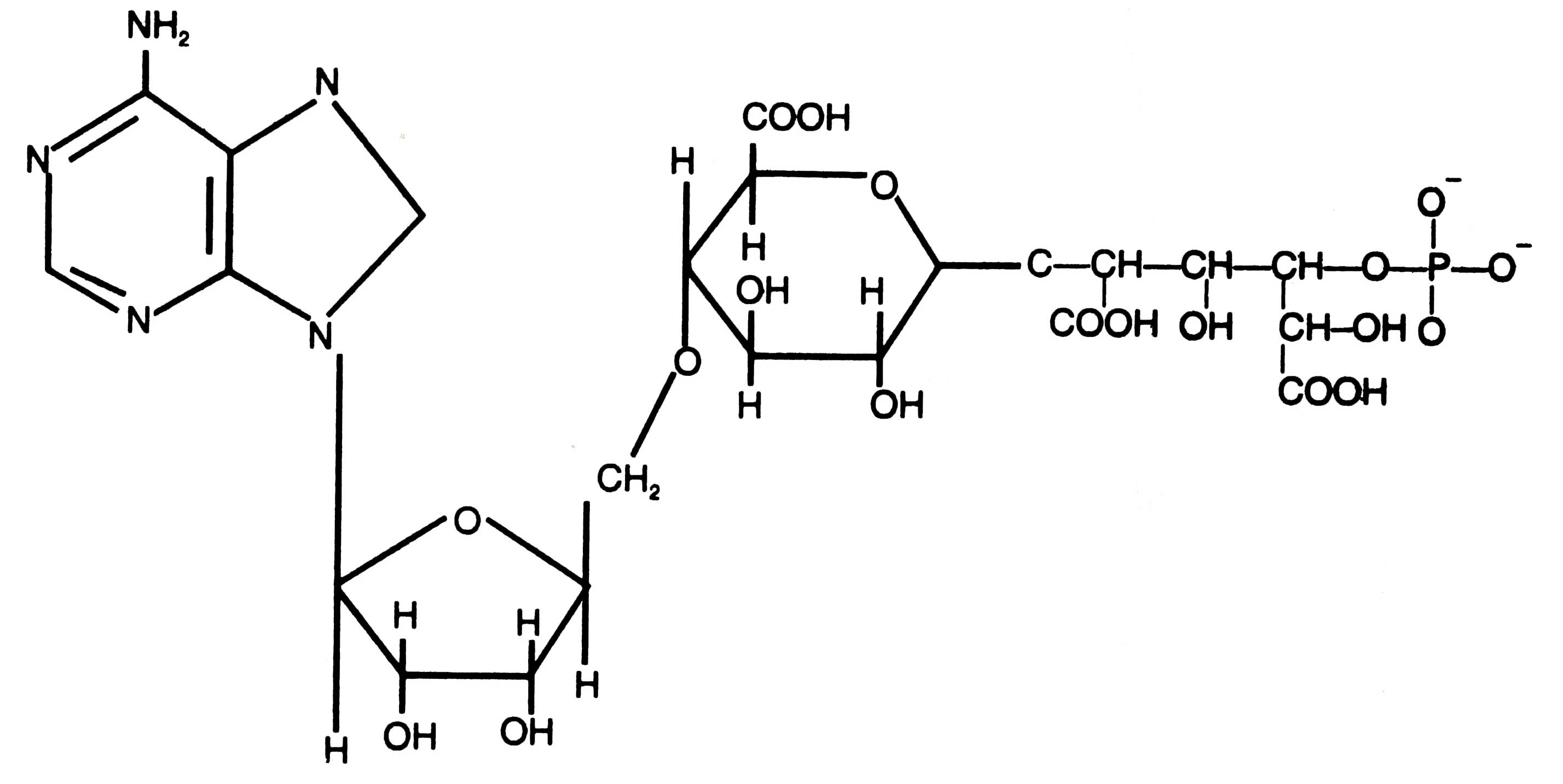Biocontrol of Insect Pests
Bacterial pesticides
B. thuhngiensis is a widely distributed bacterium. It can be isolated from soils, litters, and dead insects. It is a spore forming bacterium and produces several toxins viz., a-, b-and d-exotoxins and d-endotoxin which can be obtained in crystalline forms. b-exotoxin contains adenin, ribose, glucose, etc. (Me Connell and Richards, 1959), whereas 5-endotoxin is composed of a glycoprotein subunit (Bulla et ah, 1977). These toxins have insecticidal properties. Structural formula of b-exotoxin is given in Fig. 13.6. Bacillus thuringiensis, has been found a strong antagonist to be used as a biocontrol agent. It is an aerobic and spore forming bacterium, pathogenic to larvae of lepidoptera. After ingestation of spores, larvae are damaged, as the rod-shaped bacterial cell secretes at the opposite end, a single large crystal in the cell. This crystal (toxin) is proteinaceous in nature. It gets dissolved in alkaline solution and in alkaline juice of caterpillar's digestive cavity (Riviere, 1977).
Moreover, presence of plasmids in bacterial cells and synthesis of toxins in the form of crystals have been reported. The expression of crystal formation by the plasmid of B. thuringiensis in the transformed cells of B. subtilis and E. coli through gene cloning has also been confirmed (Schnepf and Whiteley, 1981).
Microbial pesticides are produced by many companies by using viruses, bacteria and fungi. B. thuringiensis preparations have been produced in the erstwhile U.S.A., France, U.S.S.R., etc. in the form of wettable powder and water suspensions. But in erstwhile U.S.A. the commercial formulation of b-exotoxin from B. thuringiensis has been banned.
Use of transgenic plants : a new area of biocontrol. Instead of spraying cell suspension of B. thuringiensis, scientists have now started producing transgenic plants where killer genes of bacterium are introduced. Recently, the scientists at the US Multinational Monsanto Co., Australia, Cotton Seed Distributors and the Council of Scientific and Industrial Research and Organization (CSIRO) of Australia have produced a genetically engineered species of cotton known as 'killer cotton'. It kills the predators especially the bullworm (Heliothis sp.).
The leaves of transgenic cotton plants, produced through cell culture, secrete the lethal toxins. When the bullworm eats upon cotton leaves, toxins is taken up by them. Toxin is activated in their guts resulting in death of bullworm. Toxin does not harm the spiders, humans and the other mammals.
Similarly, transgenic tobacco plants were produced through cell culture which killed hornworm (Manduca sexta).
B. thuringiensis genes have also been cloned in E. coli. Such transgenic E. coil produced larvicidal proteins in large amount which accumulate in cells to form large crystals. These are visible under light microscope (Kumar and Kumar, 1992).
Viral pesticides
A number of viruses has been discovered which belong to groups Baculoviruses and cytoplasmic polyhedrosis viruses (CPV). Preparations of viruses or their products have been developed as effective biopesticide and being successfully used for the control of insect pests in agriculture, forestry and horticulture. This method of disease control is free from pollution, toxicity or any hazards related to plant or animal health. However, these viruses are specific and have no harmful effects on useful insect pollinators, insects yielding useful products, warm blooded animals and even man (Bhagat and Bala, 1991). After application viruses get entered into the mouth and digestive tract of insect pest and kill them.
Lymantria dispar, commonly known as gypsy moth, is a serious pest of forest trees. It has been successfully controlled by gypsy moth Baculovirus i.e. NPV preparations. NPVs product has been registered under the trade name 'Gypchek' (the Environmenta Protection Agency, U.S.A) to control gypsy moth population on deciduous hardwood trees.
There is another group of virus, CPVs, which are present in more than 200 insects, out of which only a few have been used for control of insect pests. For the first time in France, a CPV of pine processionary caterpillar (Thaumetopoea pityocamps) was applied as pesticide used for the control of pine forest pests. In 1974, Japan produced a commercial preparation of CPV under the name 'Matsukemin' for the control of a pine caterpillar (Dendrolimus spectabilis). This insect was controlled fully upon application of 1011 polyhedral inclusion bodies per hectare (Katagiri, 1969).
Recent studies on the use of entomopathogenic fungi for the control of insect pests has increased the interest of mycologists throughout the world. Fungal preparations are being produced commercially. Mode of action of these fungi is different from viruses and bacteria. The infective propagules e.g. conidia, spores, etc. of the antagonistic fungi reach the haemocpel of the insect either through integument or mouth. They get attached to epicuticle, germinate and penetrate the cuticle either by germ tubes or infection peg. They multiply in haemocoel followed by secretion of mycotoxins which result in death of insect hosts. Thereafter, mycelia spread saprophytically and grow outside the integument which later on produce conidiophores and conidia (Bhagat, 1991).





